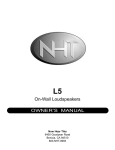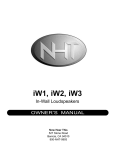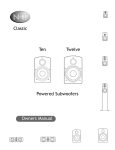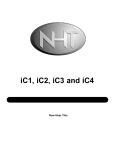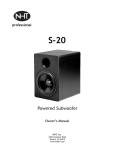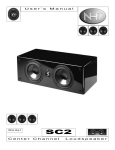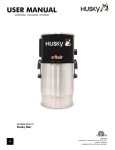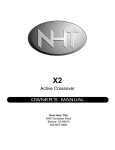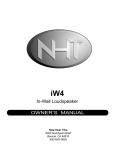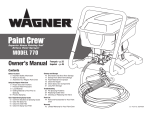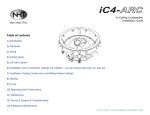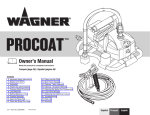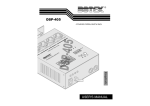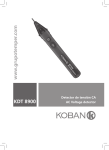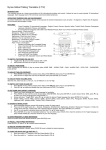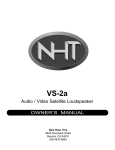Download NHT SW10 User's Manual
Transcript
User ’s Model Manual SW10 Powered ll SW12 Subwoofer IMPORTANT SAFETY INSTRUCTIONS CAUTION RISK OF ELECTRIC SHOCK DO NOT OPEN CAUTION: TO REDUCE RISK OF ELECTRICAL SHOCK, DO NOT REMOVE COVER (OR BACK). NO USER SERVICEABLE PARTS INSIDE. REFER TO QUALIFIED SERVICE PERSONNEL. The lightning flash with the arrowhead symbol, within an equilateral triangle, is intended to alert the user to the presence of uninsulated “dangerous voltage” within the product’s enclosure that may be of sufficient magnitude to constitute a risk of electric shock to persons. The exclamation point within an equilateral triangle is intended to alert the user to the presence of important operating and maintenance (servicing) instructions in the literature accompanying the appliance. WARNING: TO REDUCE THE RISK OF FIRE OR ELECTRIC SHOCK, DO NOT EXPOSE THIS APPLIANCE TO RAIN OR MOISTURE. 1. READ INSTRUCTIONS - All safety and operating instructions should be read before the appliance is operated. 2. RETAIN INSTRUCTIONS - Safety and operating instructions should be retained for future reference. 3. HEED WARNINGS - All warnings on the appliance and in operating instructions should be adhered to. 4. FOLLOW INSTRUCTIONS - All operating and use instructions should be followed. 5. WATER AND MOISTURE- The appliance should not be used near water - near bathtub, washbowl, kitchen sink, laundry tub; in a wet basement near a swimming pool, etc. 6. CARTS AND STANDS - Do not place this product on an unstable cart, stand, tripod, bracket, or table. The appliance should be used only with a cart or stand that is recommended by the manufacturer. 7. VENTILATION - The appliance should be situated so that its location and position do not interfere with proper ventilation. The appliance should not be situated on a bed, sofa, rug, or any surface that may obstruct cabinet openings. 8. HEAT - The appliance should be situated away from heat sources such as radiators, heat registers, stoves, or other devices (including amplifiers) that produce heat. 9. POWER SOURCES - This product should be operated only from the type of power source indicated on the marking label. If you are not sure of the type power supply in your home, consult your product dealer or local power company. For products intended to operate from battery power or other sources, refer to the operating instructions. 10. POWER CORD PROTECTION - Power supply cords should be routed so that they are not likely to be walked upon or pinched by items placed upon or against them, paying attention to cords and plugs, convenience receptacles, and the point where they exit from the appliance. 11. POLARIZED PLUG - This appliance is equipped with a polarized line plug (a plug having one blade wider than the other). This plug will fit into the power outlet only one way. This is a safety feature. If you are unable to insert the plug fully into the outlet, try reversing the plug. If the plug still fails to fit, contact your electrician to replace your obsolete outlet. Do not attempt to defeat this safety feature. 12. LIGHTNING - For added protection for this product during a lightning storm, or when it is left unattended and unused for long periods of time, unplug it from the wall outlet and disconnect the antenna or cable system. This will prevent damage to the product due to lightning and power line surges. 13. OVERLOADING - Do not overload wall outlets, extension cords, or integral convenience receptacles, as this can result in a risk of fire or electricshock. 14. CLEANING - Unplug this product from the wall outlet before cleaning. Do not use liquid cleaners or aerosol cleaners. Use a damp cloth for cleaning. 15. NON-USE PERIODS - This amplifier should be unplugged from the outlet when the appliance is left unused for a long period of time. 16. OBJECT AND LIQUID ENTRY - Never push objects of any kind into this product through openings, as they may touch dangerous voltage points or short-out parts that could result in a fire or electric shock. Never spill liquid of any kind on this product. 17. DAMAGE REQUIRING SERVICE - The appliance should be serviced by qualified personnel when: a. The power supply cord or plug has been damaged; or b. Objects have fallen on or liquid has been spilled into the appliance; or c. The appliance has been exposed to rain; or d. The appliance does not appear to operate normally or exhibits a marked change in performance; or e. The appliance has been dropped or the enclosure is damaged. 18. SERVICING - Do not attempt to service this product yourself, as opening or removing covers may expose you to dangerous voltage or other hazards. Refer all servicing to qualified service personnel. For service warranty information call the NHT Hotline number: 1-800-NHT-9993. 19. REPLACEMENT PARTS - When replacement parts are required, be sure the service technician has used replacement parts specified by the manufacturer or that have the same characteristics as the original part. Unauthorized substitution may result in fire, electric shock, or other hazards. 20. SAFETY CHECK - Upon completion of any service or repairs to this product, ask the service technician to perform safety checks to determine that the product is in proper operating condition. CAUTION TO PREVENT ELECTRIC SHOCK, DO NOT USE THIS (POLARIZED) PLUG WITH AN EXTENSION CORD, RECEPTACLE OR OTHER OUTLET UNLESS THE BLADES CAN BE FULLY INSERTED TO PREVENT BLADE EXPOSURE. Thank you for your purchase of the NHT SW10 ll or SW12 powered subwoofer. Like all NHT loudspeakers, the SW10 ll and SW12's development has been guided by the study of human hearing, it’s design rigorously tested, and its components optimized to deliver clean, clear musical sound. Since the quality of your speakers is one of the most important factors in maximizing the sound you'll get from your music and home theater system, we're sure that you'll find your purchase of the SW10 ll and SW12 a good investment, and invite your comments. If you find your experience with the SW10 ll and SW12 as satisfying as we believe you will, and wish to enjoy its high quality sound through your entire system, you'll find information about other sonically matched NHT Super Series loudspeakers on the back of this manual. Background The NHT SW10 ll and SW12 Powered Subwoofer is a compact, versatile and powerful amplified subwoofer designed to provide low frequency reinforcement for high performance audio and home theater systems. The SW10 ll and SW12 features: • line-level and speaker-level inputs, for connection with all types of receivers or other audio components • independent gain, phase and low pass filter controls • boundary control for adjusting system sound for various room placement Please take a few minutes to read through this owner's manual before setting up your speakers; this information will help you get the most out of them. Also, please keep the SW10 ll or Sw12’s packaging to use in case you move or transport them. If you have questions at any time during setup or use, feel free to call your NHT dealer or our Toll-Free Customer Hotline at 1-800-NHT-9993. Placement Note: To prevent the SW10 ll and SW12 subwoofer amplifier from overheating, always be sure to provide adequate space for proper ventilation. Do not place the subwoofer directly against the wall or any other surface. The key to placing your subwoofer for optimal enjoyment is to remember that low frequencies produce sounds with long wavelengths, which interact in complex ways with room boundaries, such a walls and corners, and other large objects as well. Placing the subwoofer near to a room boundary will tend to increase its apparent bass output, but may result in "boomy" or "muddy" sound. Conversely, placing it farther away from room boundaries will tend to decrease its apparent bass output, but may result in improved articulation and clarity. When possible, place the subwoofer in the same horizontal plane and along the same wall as the main speakers. And since small changes in subwoofer position can have a significant effect on sound, experimenting with the effects of different placements in your own listening/viewing room is the key to finding the sound you like best. SW10 ll and SW12 Features & Controls Volume: This control allows you to adjust the gain of the Subwoofer relative to the rest of your system. Many listeners make the mistake of setting subwoofers too loud, which can cause excess bloat and loss of detail and musicality. A properly calibrated subwoofer blends in with the speakers and does not call attention to itself. To properly set volume: • Turn down the volume control on the SW10 ll or SW12 to its lowest position (counter-clockwise). • Turn on your audio system, including the SW10 ll or SW12. Play some music you are familiar with and set your receiver/preamplifier volume to a comfortable listening level. • Slowly increase the volume of the SW10 ll or SW12, listening for proper frequency balance. When balanced, you will hear improved bass extension, but not be aware that it is coming from the subwoofer. From this point on, the volume control on your receiver/preamplifier will control the overall volume of your system, including the subwoofer. The Boundary EQ: This is a feature unique to NHT Evolution products. Reflective boundaries (such as walls) reinforce a speaker’s bass output (3dB for two walls, 6dB for a corner) if the subwoofer is placed near them. Conversely, placing a subwoofer out in the room results in a relative decrease in bass output. Boundary reinforcement may lead to low frequency response that is uneven. Some frequencies will sound exaggerated relative to others, or the subwoofer will sound thin and lack impact. The Boundary EQ control allows you to compensate for the effects of room boundaries on the frequency response of the subwoofer. Adjusting the control enables you to achieve smooth low frequency output from the subwoofer regardless of its location in your room. The following diagrams shown in Fig. 1 show the correlation between subwoofer placement and Boundary EQ. These diagrams are guidelines only. Your room acoustics and personal tastes will ultimately dictate the final setting. Fig. 1 Boundary Half Space +3dB 0 -3dB Two tips on using the Low Pass Filter: As a starting point, set Low Pass Filter to the 1 o’clock position. This will result in an 80Hz low pass. As the setting is typical for most Dolby Digital / DTS applications. Note: The LFE input bypasses the adjustable 12dB Low Pass Filter. See the Fine-Tuning section for further adjustment guidelines. SUBWOOFER PHASE: This switch sets the phase of the subwoofer at either the 0° position (normal phase) or the 180° position (reverse phase) to achieve the smoothest possible bass response in your system. This phase-reversing option is important because if bass frequencies come from both the subwoofer and the main speakers, peaks and dips in the frequency response can occur at the listening position. In these cases, reversing the subwoofer phase can improve blending and balance. To properly set the Subwoofer Phase: • Play familiar music, reversing phase settings. And listen from your usual position. Quarter/ Half Space Half/ Whole Space Boundary +3dB • Avoid evaluating while standing above the subwoofer or amplifier; sound at the listening position will be significantly different. 0 -3dB Boundary +3dB 0 -3dB LOW PASS FILTER: This control determines the upperlimit frequency the subwoofer will reproduce. For example, setting the filter at 100Hz will cause the subwoofer to reproduce only frequencies below 100Hz. The Low Pass Filter is continuously variable between 40Hz (low bass) and 180Hz (upper bass), to accommodate different speakers. • The correct setting is the one in which the bass is the loudest at the listening position. POWER MODE: This feature automatically switches your SW10 ll or SW12 into minimum-power mode (ie, sleep) whenever no signal is present for 20 minutes. When a signal is received, it immediately turns on again. As AUTOMode is automatic, it requires no adjustment, nor is there a need to turn the SW10 ll or SW12 on and off every time it is used. When in ON Mode, the subwoofer is always on. 9 8 7 4 3 Line Input LFE Low Pass Filter In L Out R 40Hz 180Hz Power Mode Hi Level Input Volume Max Min Phase Boundary On 180 Auto 0 +3dB 5 0 + L - - R -3dB 6 1 + Green - On Amber - Standby Red - Protect On Power Powered Subwoofer Off 2 10 11 T3.0AL 250V For 115 V T2.0AL 250V For 230V Input Voltage 115 115V 60Hz / 230V 50Hz~ 300W CAUTION: FOR CONTINUED PROTECTION AGAINST FIRE, REPLACE ONLY WITH SAME TYPE 250V FUSE 12 WARNING: Connecting The SW10II OR SW12 Caution: Before connecting the SW10II OR SW12 to your audio system, it is important to unplug or turn off all AC power connections to connected components such as receivers, amplifiers, preamplifiers, and processors. Do not plug in or connect the SW10II OR SW12 subwoofer to AC power until all connections have been made. Integrating the SW10II or SW12 into your surround system is simple and straightforward when using this connection method. Your AV Receiver will control all crossover functions and the SW10II or SW12 will control Subwoofer gain, phase and boundary equalization. TO REDUCE THE RISK OF FIRE OR ELECTRIC SHOCK, DO NOT EXPOSE THIS APPLIANCE TO RAIN OR MOISTURE. CONFORMS TO ULSTD.6500 CAUTION RISK OF ELECTRIC SHOCK DO NOT OPEN CERTIFIED TO CAN/CSA STD.E60065 WARNING: SHOCK HAZARD-DO NOT OPEN. AVIS: RISQUE DE CHOC ELECTRIQUE-NE PAS OUVRIR. 2001228 13 Back of Subwoofer (refer to diagram above) (1) Power Mode - Leaves Subwoofer in permanantly on (ON), or puts the subwoofer in automatic standby mode (AUTO). Connect the Subwoofer/LFE Output on your AV Receiver to the LFE IN on the back of the SW10II or SW12. (Fig. 2) Main Speakers Reciever LFE / Sub SPEAKER OUTPUTS L R + - (2) Power Indicator - The light is green when the subwoofer is on. The light is amber when the subwoofer is in stand-by mode. The light is red when the subwoofer is in protection. SW10 / SW12 Back of Subwoofer (3) Volume Control - Adjusts the loudness of the subwoofer independently of the main speakers. Line Input LFE Low Pass Filter In (4) Low-Pass Filter - Continuously variable low-pass crossover control. (5) Boundary Switch - Selects response mode of subwoofer, depending on placement. (6) Subwoofer Phase Selector - 2-position selectable phase control for subwoofer. (0 - 180) Out R 40Hz 180Hz Power Mode Hi Level Input Fig. 2 Volume L Min Max Phase Boundary On 180 Auto 0 +3dB 0 + L - - R -3dB + (7) Line Input - Low level RCA input jacks for L/R signals In the event your receiver or pre-amp does not have a LFE or Subwoofer output the SW10II/SW12 has two additional connection methods: (8) LFE In/Out - Low level RCA input jack for LFE or subwoofer signal. Out is an unbuffered pass through used for multiple subwoofers. 1) Line Level Use if: (9) Hi Level Input - Speaker level input connector. (10) Power Switch - Turns the unit on and off 115 You have an amp or receiver with Pre-Out jacks but no LFE/Subwoofer jacks. (11) Fuse Holder - location of the user servicable fuse (12) Power Inlet - For universal AC line input connection (13) Input Voltage Switch - Selects 115 VAC or 230 VAC mains voltage. To connect for a Line Level signal (Fig. 3), keep your main speakers connected as usual, but use RCA linelevel cables to connect as follows: • Preamps with Line Out jacks: connect one pair of Line Out cables to your main amp to power your main L & R speakers, and a second pair to the SW10II OR SW12 LINE LEVEL INPUT. If your preamp has only one pair of Line Out jacks, you can use a pair of "Y" connector cords, available through your NHT dealer. Main Speakers Reciever SPEAKER OUTPUTS L R Pre Out L R component's speaker output terminals to the L & R speakers, and a second pair from the same output terminals to the SW10II OR SW12's High-Level input. The SW10II OR SW12's input does not present a significant load to the receiver, and will not compromise its output to the L & R speakers. If you find that your receiver will not accommodate more than one cable per output terminal, check with your NHT dealer for alternative methods of connection. + - Main Speakers Reciever SPEAKER OUTPUT SPEAKER OUTPUT LEFT - SW10 / SW12 Back of Subwoofer Line Input LFE Low Pass Filter In L Out R Fig. 3 - + Volume SW10 / SW12 Back of Subwoofer 40Hz 180Hz Power Mode Hi Level Input RIGHT + Min Max Phase Boundary On 180 Auto 0 +3dB 0 + L - - R -3dB + Line Input LFE Low Pass Filter In Out • Amps and receivers with Pre-Out jacks: connect the SW10II OR SW12 from the Pre-Out into the SW10II OR SW12's Line Input. 2) Hi-Level 115 Use if: Your receiver has no Pre Out or Subwoofer/LFE Out jacks To connect for a High-Level signal (Fig. 4), use two additional pairs of speaker cables, and connect as follows: • For amps and receivers with separate A and B speaker outputs, connect one pair of speaker cables from your receiver's Speaker A outputs to your main L & R speakers, and a second pair from your receiver's Speaker B outputs to the SW10II OR SW12's High-Level Input. Use this method only if both A & B speaker outputs can operate simultaneously. • For amps and receivers with only one set of speaker output terminals, simply feed the same signal, in parallel, to both your main L & R speakers and the SW10II OR SW12. Connect one pair of speaker cables from your R 40Hz 180Hz Power Mode Hi Level Input Fig. 4 Volume L Min Max Phase Boundary On 180 Auto 0 +3dB 0 + L - - R -3dB + With all signal connections complete, it is now time to apply AC power. Plug the power chord into the power inlet in the back of the subwoofer, plug the other end into into the wall outlet and switch the subwoofers power to the ON position. 115 The frequency chart below lists some terms commonly used to describe different bands of the frequency spectrum. Listen to your system and make adjustments to achieve a seamless blend between your main speakers and the SW10 ll or SW12. Four common problems are outlined below. Follow the flow chart to correct these. See the glossary for any terms you are unfamiliar with. Fine Tuning the Subwoofer The key to good subwoofer / speaker integration is repeated listening, followed by making small re-adjustments of the subwoofer controls. The most important bass tuning functions you will control are the LOW-PASS FILTER, followed by the VOLUME CONTROL settings and then PHASE SELECTOR. Frequency Chart Low Bass Mid Bass Upper Bass Below 50Hz 50Hz-100Hz 100Hz-180Hz Lower Mid 180Hz-300Hz Mid 300Hz-700Hz Upper Mid High 700Hz-3K 3K and above Problem "Boomy" Too Much Mid / Upper Bass Lacks Mid / Upper Bass: Lean But With Weight Solution Fine Tuning Flow Chart Adjust Subwoofer Phase 0-90 Adjust Subwoofer Phase 0-90 (Continuously Add) (Continuously Add) Lower Low Pass X-Over Frequency If this makes it worse, try If the sound improves Lower Subwoofer Volume Listen Adjust Subwoofer Volume Listen Raise Low-Pass Setting Adjust Subwoofer Volume Adjust Subwoofer Phase Listen Lacks Low Bass Weight Excessive Low Bass Weight Adjust Subwoofer Phase Switch 0-180 Decrease Boundary EQ Increase Boundary EQ Move Subwoofer Closer to Wall Listen Move Subwoofer Farther From Wall Listen Operation We recommend that the SW10 ll or SW12 power be left on, which will allow the built-in Auto Mode feature to disable the subwoofer when not in use. Every speaker, has limits, and it's important to listen for them. Speaker damage most often results not from brief loud musical peaks, but from sustained high volume levels in some or all frequencies. For this reason, extreme volume settings and excessive bass, treble or equalizer boosts are not recommended. If you hear unusual distortion or breakup, or notice heat coming from the woofer, decrease volume immediately, neutralize any excess bass, treble or equalizer boosts, and avoid setting any controls to similar extremes again. Maintenance appropriate type. • reinstall the fuse holder Always replace the fuse with one of the exact same specifications. SW10 ll: For systems operating at 115 volts, use only a 5x20 mm, T3A, 250-volt slow-blow fuse. For systems operating at 230 volts, use only a 5x20 mm, T2.0A, 250-volt slow-blow fuse. SW12: For systems operating at 115 volts, use only a 5x20 mm, T5A, 250-volt slow-blow fuse. Your SW10 ll and SW12 is designed for years of use with no or minimal maintenance, as long as you avoid exposing it to direct sunlight, high temperatures, or moisture. Clean cabinets, when necessary, using a damp cloth or a mild, non-abrasive cleaner; to clean grilles, remove from speaker and use a soft brush or a vacuum on its lowest setting. Do not attempt to clean the actual driver. For systems operating at 230 volts, use only a 5x20 mm, T2.5A, 250-volt slow-blow fuse. 9.8 Changing the Line Voltage Setting If the SW10 ll or SW12 turns on but the LED indicator fails to illuminate, mis-wiring or a power surge may have caused the protection fuse to blow. Replace it with one of correct type and value. The SW10 ll and SW12 were designed to operate on two line voltage settings, 115VAC and 230VAC. In the event that it is necessary to change the line voltage setting, begin by turning the power switch to the off position. Remove all the connections from the amplifier, including the detachable power cord. Using a flat blade screwdriver, slide the switch to the correct position. Use the 115VAC position for 110 to 120 VAC, and the 230VAC position for 220 to 240 VAC. Next you will likely need a power cord that fits the AC receptacle and you will need to replace the fuse (see "Changing the Fuse" below) Troubleshooting If the SW10 ll or SW12 fails to operate at all when the Power Switch is turned on, thoroughly check the power cord, input and output connections If the SW10 ll or SW12 turns on but its status LED stays red, the unit is gone into protect mode, which could be caused by incorrect wiring, short circuits, or excessive volume. Turn off the Power Switch on the subwoofer for two or more seconds to reset, and double check all speaker cables to be sure that no small metal strands are shorting the terminals. If these steps don't restore the SW10 ll or SW12 to operation, contact your local Authorized NHT Dealer or NHT for assistance. Changing the Fuse Satisfaction The SW10 ll and SW12 amplifier's fuse is user-serviceable. To replace it: • turn the power OFF • unplug the power cord • remove the fuse holder cover (above to the power inlet) with a flat blade screwdriver • remove the fuse from the holder and replace it with the Your satisfaction with your new NHT SW10 ll or SW12 Subwoofer is important to us. Please note the matched products and accessories we provide for them, and your warranty, printed on the back of this manual. If you have any questions regarding your speakers' use, feel free to call NHT at 1-800-NHT-9993. Enjoy your listening and viewing! Glossary the back of a receiver, integrated amplifier or power amplifier. Active: Uses electrical power. Midrange: The frequency span in the middle of the audio Amplifier: An electronic device that increases the cur- range, roughly 180Hz - 3000Hz. Also used to describe rent and/or voltage of a signal, providing power to the the driver that reproduces these frequencies. loudspeakers (i.e. power amplifier, integrated amplifier, Ohm: A unit of electrical resistance. That which opposes receiver). an electric current in a conductor. In audio, a measure of Bass: The range of audio frequencies below 180Hz, the load presented by a device to an electrical source. characterized by low pitch. Out-of-Phase: The polarity of an audio signal when Crossover: An electronic circuit that divides an audio connected as follows: (+) to (-) and (-) to (+). signal into different frequency ranges. Passive: Uses no electrical power. Distortion: Any deviation from the original signal. Phase: An expression of the relative polarities of two sig- Driver: The moving part of a loudspeaker, which radiates nals. sound energy. Power Handling: The ability of a loudspeaker to operate Dynamics: Variations in loudness of sound. without large increases in distortion when given varying Frequency: A rate of vibration, which corresponds to amounts of input power. musical pitch, expressed in Hertz (Hz). Preamplifier: An electronic device that selects sources Full Range: A signal encompassing the entire audible and passes line-level signals to an amplifier. frequency spectrum. Pre-Out: A preamp line-level RCA output on the back of Hertz (Hz): A unit equal to one cycle per second, used to a receiver, integrated amplifier or preamplifier. measure the frequency of a signal or sound. Receiver: A preamplifier, amplifier and tuner built into High-Pass Filter: A filter that passes only high frequen- one chassis. cies above a lower limit. Satellite: Front L & R speakers when used with a sub- Impedance: A measure of the total opposition to current woofer. Also referred to as "main speakers". flow in an alternating current circuit, measured in ohms. Sensitivity: A ratio of voltage across the speaker load to In Phase: The polarity of an audio signal when connect- the acoustic power output, measured in decibels. ed as follows: (+) to (+) and (-) to (-). Sub Out: An line level output for connection to a sub- Integrated Amplifier: A preamplifier and amplifier built woofer or subwoofer signal processor. into one chassis. Subwoofer: A driver designed to operate over the low Interconnect Cable: A length of shielded wire with plugs bass portion of the audio range. Also refers to a system at both ends for feeding signals from one electronic consisting of a woofer and its enclosure, which are phys- device to another. ically separate from the upper range loudspeakers. L.F.E.: "Low Frequency Effects"; The .1 channel of infor- Surround Speakers: Speakers located in the side or mation recorded on most multichannel digital sound for- rear for surround channel effects. mats. Treble: The upper part of the frequency spectrum, con- Line-Level Connection: Low level RCA/phono or XLR sisting of frequencies above about 3000Hz. type connection. Tweeter: A small driver designed to reproduce high fre- Load: A term used to describe the impedance that a quencies. speaker presents to an amplifier. Watt: A measure of electrical power, combining the volt- Low-Pass Filter: A filter that passes only low frequen- age with the electrical current required to drive the loud- cies below a higher limit. speaker. Main Speakers: Front L & R channel speakers, some- Weight: Low frequencies below 50Hz. times referred to as satellites. Woofer: A driver designed to operate over the bass por- Main-In: A line-level RCA/XLR power amplifier input on tion of the audio range. S p e c i f i c a t i o n s All Super Series products are sonically matched for seamless integration into multichannel systems. Super Series SB1 System Type 2-Way Acoustic Suspension SB2 2-Way Acoustic Suspension SB3 2-Way Acoustic Suspension ST4 3-Way Acoustic Suspension SC1 SC2 2-Way Acoustic Suspension 2-Way Acoustic Suspension SW10 SW12 Vented / Powered - 150 watts Class G Amplifier Vented / Powered - 250 watts Class G Amplifier 10” Aluminum (Not Video Shielded) 12” Aluminum (Not Video Shielded) 31Hz - 180Hz +/- 3dB 27Hz - 180Hz +/- 3dB Driver Complement Tweeter- 1” fluid cooled aluminum dome tweeter with neodymium magnet structure Woofer- 5.25” Polypropylene 6.5” Polypropylene 6.5” Polypropylene Video Shielded Unless Noted 6.5” and 8” Polypropylene (2) 4.5” Polypropylene (2) 5.25” Polypropylene (8” Not Video Shielded) Response 68Hz - 22kHz +/- 3dB 51Hz - 22kHz +/- 3dB 39Hz - 22kHz +/- 3dB 31Hz - 22kHz +/- 3dB 78Hz - 22kHz +/- 3dB 73Hz - 22kHz +/- 3dB 86dB / 2.83v 86dB / 2.83v 86dB / 2.83v 86dB / 2.83v 86dB / 2.83v 87dB / 2.83v 8 ohm nominal 8 ohm nominal 8 ohm nominal 8 ohm nominal 8 ohm nominal 8 ohm nominal Minimum 15 watts Minimum 15 watts Minimum 15 watts Minimum 15 watts Minimum 15 watts Minimum 15 watts Maximum 125 watts Maximum 150 watts Maximum 175 watts Maximum 200 watts Maximum 150 watts Maximum 175 watts 8 lbs. 13 lbs. 16 lbs. 47.5 lbs. 11 lbs. 22 lbs. 39.5 lbs. 47.5 lbs. 6.75 x 6.25 x 10.25 8.75 x 7.5 x 11.85 10 x 8 x 13 12 x 8 x 38 6.63 x 16.54 x 5.63 8.5 x 19 x 6.5 14 x 12 x 18 16 x 14 x 20 White or Black High Gloss Piano Finish White or Black High Gloss Piano Finish Black High Gloss Piano Finish Black High Gloss Piano Finish Black High Gloss Piano Finish Black High Gloss Piano Finish Black High Gloss Piano Finish Black High Gloss Piano Finish Sensitivity Impedance Recommended Amplifier Power Weight Dimensions Depth” x Width” x Height” Finish Limited Warranty Valid Only in the U.S.A. Warranty Period For a period of 5 years for parts and 5 years for labor (1 year parts and 90 days labor for electronics) from the date this product is first purchased from an authorized NHT dealer, Now Hear This (NHT) warrants that if it fails to function properly due to a manufacturing defect, despite its being installed and operated according to these instructions and used under normal conditions, it will be either replaced or repaired with new or rebuilt parts (both at NHT's option) with a unit of comparable value without charge to you. What's Not Covered Altered, defaced or removed serial numbers void this warranty. This warranty does not cover any product used in trade, business, industrial or commercial applications. This warranty also does not cover the cabinet or appearance factors, or costs, defects or damage resulting from misuse, abuse, accident, improper maintenance, alterations or modifications not authorized in writing by NHT, or parts or labor from any source other than an authorized NHT service location. Damage due to power exposure in excess of the speaker's published power ratings; ie, overpowering, lightning or power surges, are also not covered. Your Rights This warranty gives you specific legal rights, and you may have other rights which vary from state to state. NHT limits this warranty to the purchase price of the product, excludes incidental or consequential damages, and limits its obligations under any implied warranties under state laws to a period not exceeding their warranty periods. As some states do not allow the above limitations, however, they may not apply to you. To Obtain Service To find the name and address of the nearest authorized NHT service location, call or write: Customer Service Department, NHT, 527 Stone Rd., Benicia, CA 94510, 1-800-NHT-9993 (648-9993), www.nhthifi.com For your future convenience, please keep this warranty with your sales receipt, and record date and place of purchase for further reference.










